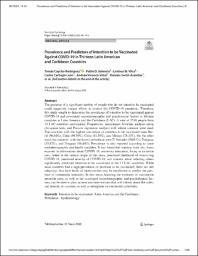Mostrar el registro sencillo del ítem
Prevalence and Predictors of Intention to be Vaccinated Against COVID‑19 in Thirteen Latin American and Caribbean Countries
| dc.contributor.author | Caycho‑Rodríguez, Tomás | es_ES |
| dc.contributor.author | Valencia, Pablo D. | es_ES |
| dc.contributor.author | Vilca, Lindsey W. | es_ES |
| dc.contributor.author | Carbajal‑León, Carlos | es_ES |
| dc.contributor.author | Vivanco‑Vidal, Andrea | es_ES |
| dc.contributor.author | Saroli‑Araníbar, Daniela | es_ES |
| dc.date.accessioned | 2022-10-18T19:25:21Z | |
| dc.date.available | 2022-10-18T19:25:21Z | |
| dc.date.issued | 2022-03-21 | |
| dc.identifier.uri | https://hdl.handle.net/20.500.13053/6869 | |
| dc.description.abstract | The presence of a significant number of people who do not intend to be vaccinated could negatively impact efforts to control the COVID-19 pandemic. Therefore, this study sought to determine the prevalence of intention to be vaccinated against COVID-19 and associated sociodemographic and psychosocial factors in thirteen countries in Latin America and the Caribbean (LAC). A total of 5510 people from 13 LAC countries participated. Frequencies, percentages, bivariate analyses using chi-square tests, and Poisson regression analysis with robust variance were used. The countries with the highest prevalence of intention to be vaccinated were Bra-zil (96.94%), Cuba (89.59%), Chile (84.59%), and Mexico (78.33%). On the other hand, the countries with the lowest prevalence were El Salvador (54.01%), Paraguay (55.87%), and Uruguay (56.40%). Prevalence is also reported according to some sociodemographic and health variables. It was found that country, male sex, hours exposed to information about COVID-19, university education, living in an urban area, belief in the animal origin of the virus, perceived likelihood of contracting COVID-19, perceived severity of COVID-19, and concern about infecting others significantly predicted intention to be vaccinated in the 13 LAC countries. While most countries had a high prevalence of intention to be vaccinated, there are still subgroups that have levels of intention that may be insufficient to predict the pres-ence of community immunity. In this sense, knowing the estimates of vaccination intention rates, as well as the associated sociodemographic and psychological fac-tors, can be used to plan actions and interventions that will inform about the safety and benefits of vaccines, as well as strengthen trust in health authorities. | es_ES |
| dc.format | application/pdf | es_ES |
| dc.language.iso | eng | es_ES |
| dc.publisher | Springer Science and Business Media Deutschland GmbH | es_ES |
| dc.rights | info:eu-repo/semantics/openAccess | es_ES |
| dc.rights.uri | https://creativecommons.org/licenses/by/4.0/ | es_ES |
| dc.subject | Intention to be vaccinated · Latin America and the Caribbean · Prevalence · Epidemiology | es_ES |
| dc.title | Prevalence and Predictors of Intention to be Vaccinated Against COVID‑19 in Thirteen Latin American and Caribbean Countries | es_ES |
| dc.type | info:eu-repo/semantics/article | es_ES |
| dc.identifier.doi | https://doi.org/10.1007/s43076-022-00170-x | es_ES |
| dc.type.version | info:eu-repo/semantics/publishedVersion | es_ES |
| dc.publisher.country | BR | es_ES |
| dc.subject.ocde | http://purl.org/pe-repo/ocde/ford#3.03.00 | es_ES |
Ficheros en el ítem
Este ítem aparece en la(s) siguiente(s) colección(es)
-
SCOPUS [380]


